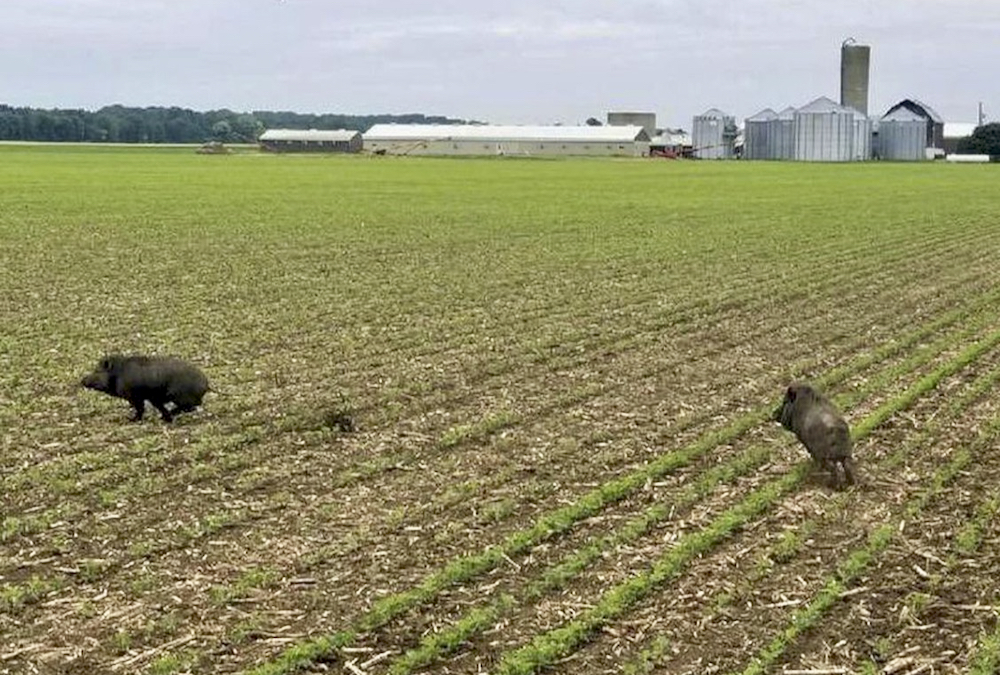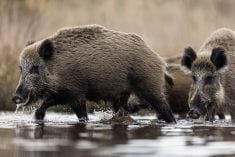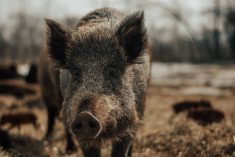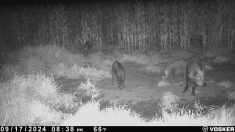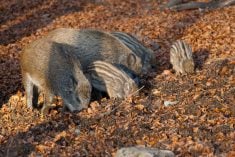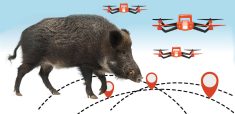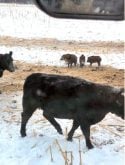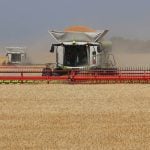[UPDATED: Dec. 8, 2021] Experts worry that Manitoba’s wild pig population and domestic hog production are on a collision course, something that can only be a bad thing when it comes to disease.
Ryan Brook, a professor at the University of Saskatchewan, has spent the last 12 years trying to track Canada’s wild pig population and range, and is one of the country’s leading voices on wild pig research.
His research has shown an exponentially growing problem on the Prairies, and in Manitoba and Saskatchewan in particular. Spruce Woods, for example, certainly has a long-established population at least in the “hundreds,” Brook said.
Read Also

MANITOBA AG DAYS 2026: Stacked equipment category expected at Innovation Showcase
Ten of 28 Innovation Showcase entries at the Manitoba Ag Days 2026 farm show Jan. 20-22 in Brandon are in the equipment category.
Municipalities like the RM of Glenboro-South Cypress and RM of Victoria now report similar numbers of wild pig instances as some wild pig hotbeds in eastern Saskatchewan, according to maps published by the researcher early this year.
Why it matters: ASF in Europe provides one first-class example of a disease in wild swine becoming a serious headache for pork producers.
Manitoba’s now perennial battle with porcine epidemic diarrhea (PED) highlights the issue. Infamous for being deadly to young piglets (mortality ranges are commonly cited anywhere from 80 to 100 per cent), Manitoba has not gone a year without new PED cases since it was first detected in 2014.
This November, Manitoba’s chief veterinary officer announced that PED cases had reached outbreak status once again. The province was reporting 14 cases as of Nov. 26, all cropping up since late October. More concerning than the numbers however — Manitoba saw much worse counts in 2017 and 2019 — the sector noted the geographic spread and lack of obvious links between cases.
Worst-case scenario
Should it gain a foothold in the wild pig population, the fight against PED would become significantly more complicated.
“We know globally from a lot of research and monitoring that wild pigs can be very serious reservoirs of disease and hold the disease, but also they can spread the disease either by directly contacting animals, but also indirectly through shared feed,” Brook said.
“We know also that wild pigs and domestic pigs can interbreed and so wild pigs are attracted to sow barns,” he added. “Wild pigs are attracted to the smell of pig manure… and we know that these diseases can be spread through that kind of contact. We really have to look at disease and I think that’s something that should be a priority.”
Places like South Korea and parts of the U.S. have already seen issues with PED in wild populations, he noted.
There’s also the example of Europe, where wild boar have become a vector for African swine fever. Thousands of wild boar have been found positive for ASF in places like Germany and Poland, frustrating efforts to contain and eliminate the disease.
The impact to the hog sector in those areas has been significant. Countries like China put restrictions on German pork trade after ASF was first found in the country’s wild boar in September 2020. Since then, well over 2,000 wild animals had been found ASF positive in Germany, and four east German farms have reported domestic herd infections. In September, Reuters reported that the country was implementing intense hunting along the Polish border, in the hopes of keeping ASF-infected animals from wandering in.
A bad mix
While the bulk of PED cases in Manitoba have been clustered in southeastern Manitoba, it’s areas like Spruce Woods in the southwest that are considered the epicentre for wild pigs — but both of those ranges have spread in recent years.
The province reported the first PED cases in west-central Manitoba, northeast Manitoba and the Interlake in the last two years.
Brook, meanwhile, has at least some evidence of wild pigs in various areas of eastern Manitoba and near the Manitoba-Ontario border. The list also includes major pork regions like the RM of La Broquerie.
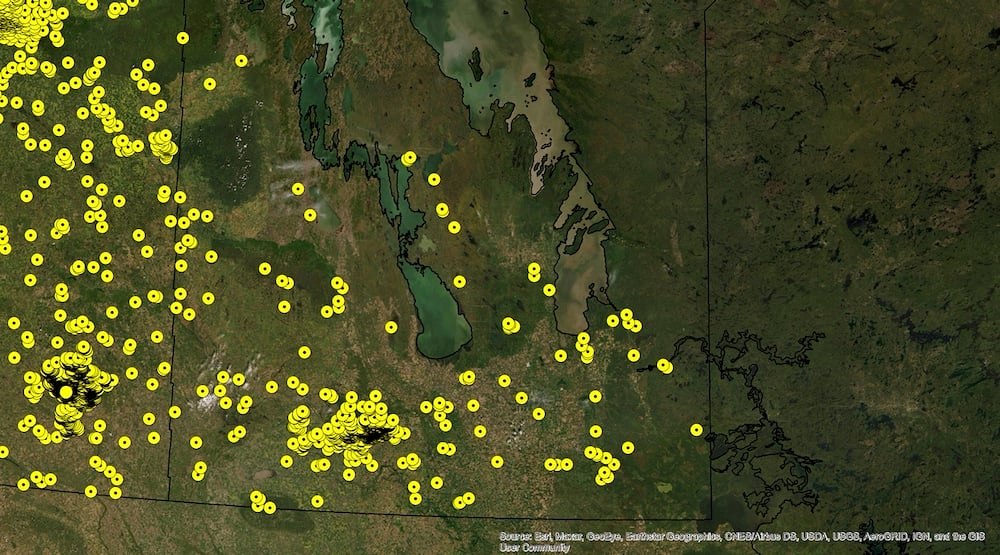
While wild pigs are notoriously elusive, Brook’s team has been gathering data on wild pig occurrences — such as tracks, rooting, trail camera images, sightings or other evidence — as well as collaring wild pigs and tracking their movements through GPS, in an effort to get some ballpark idea of population density and range.
That research has found ample evidence of overlap between wild pig range and domestic hog production.
“In some cases, these collared pigs are coming right onto farms,” he said.
Time to test?
Brook is pushing the importance of testing those wild populations for disease.
Manitoba’s wild pig program, done through the Manitoba Pork Council, currently does not include disease testing.
The program, however, also has few financial or human resources to bring to bear, according to Jenelle Hamblin, manager of swine health programs with the council. The current program is focused on quantifying the level of threat for wild pigs. The pork council says it is in conversation with the province and hopes to expand its programming into something more robust.
“Our goal is to expand those efforts into different parts of the province to get a better understanding of where they are, potentially how many there are and how they’re moving,” Hamblin said.
In 2019, the pork council announced a wild pig control program in partnership with a wildlife association in western Manitoba, although the council later noted that the volunteer program also lacked for labour.
Hamblin argued that better regional threat assessments would allow the industry to overlay their production data and get a clearer picture of the risk to the industry from wild pigs.
Doing it properly
There is little point in testing without a strategy to go with it however, Brook cautioned, while Hamblin also argued that the small scale of the council’s wild pig program means that, even if test data were collected, it would not be representative.
“There are very valid and justified concerns about just going out,” Brook acknowledged. “I would not advocate running out and testing a bunch of samples until there are plans. How do we respond if something is found? That needs to happen, but I’m not aware that, that has happened yet.”
Limited resources also emphasize the need for a realistic and strategic approach, he noted.
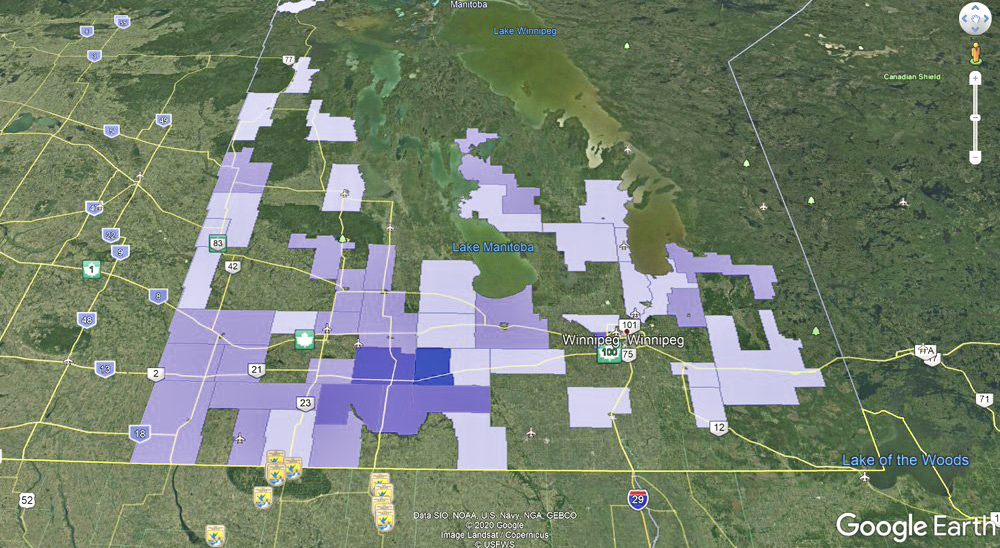
There are some parts of the country — including parts of Manitoba — where wild pigs are probably too entrenched to eliminate, he now says. There should still be control efforts in those regions, he stressed, but added that wild pig strategy must look beyond eradication, and start turning to tools like zoning.
There are large areas that could still be prioritized and kept free of wild pigs, he argued. There have been wild pig sightings east of Winnipeg, for example, but relatively few. Likewise, major pork-producing regions would be a high-value area to protect.
“I think that trying to do all of the Canadian Prairies or, indeed, all of Manitoba at this point, would require a massive effort with huge resources and so if there’s limited resources, then we really need to stop and think and ask, ‘OK, well what is the priority here? What’s the goal?’” Brook said.
Wild pig risk does feature during talks about expanding the industry right now, Hamblin said.
In particular, the pork sector outlines wild pig worries with municipalities in areas where they would like to see barns built.
Biosecurity, as a matter of course, is a “consistent and evolving conversation based on where we are at the time and what risks are present,” she said.
And while there is little Prairie-wide strategy for sharing resources, Hamblin noted they are in talks with their counterparts in other provinces on how to share information.
Brook, for his part, argues that there needs to be more than what current control programs have on offer.
“We know the pigs are spreading,” he said. “We know that they interact with farms and it’s just a matter, I think, of really thinking hard about what are our options are around getting ahead of this. It’s always cheaper and much more effective to be proactive and in front of this than trying to play catch-up after, say, there’s some animal shot on a farm and it turns out to have a disease of some sort.”
*Update: Areas where evidence of wild pigs sightings in Manitoba were updated.


